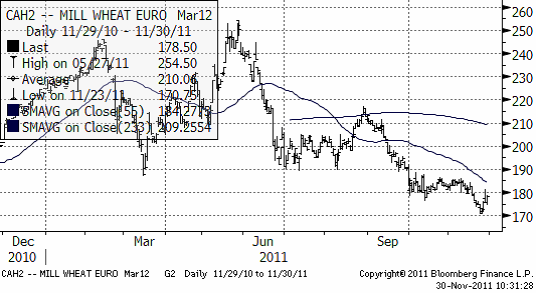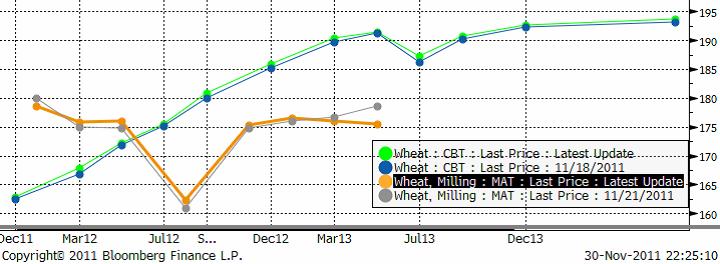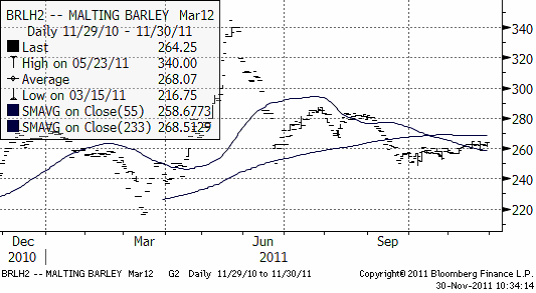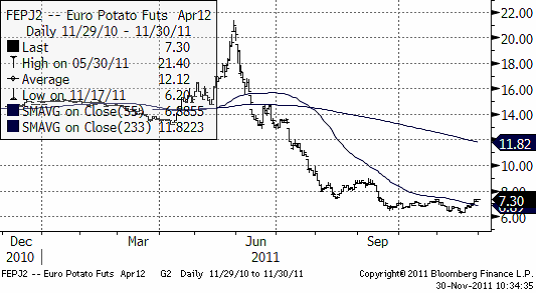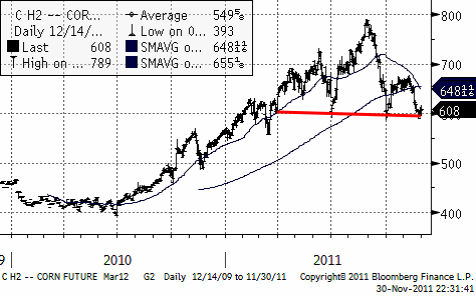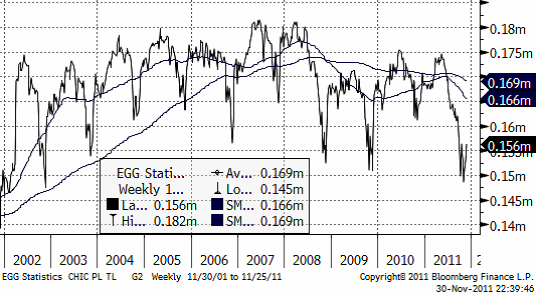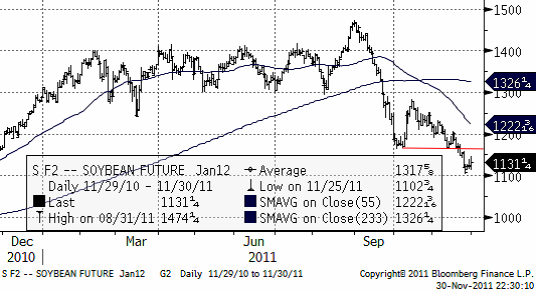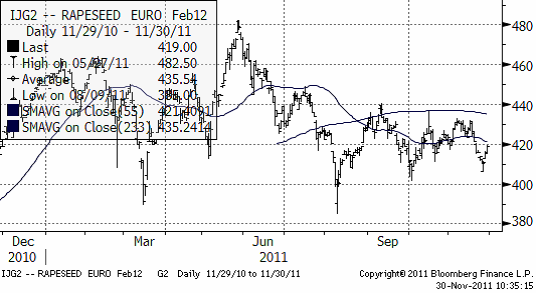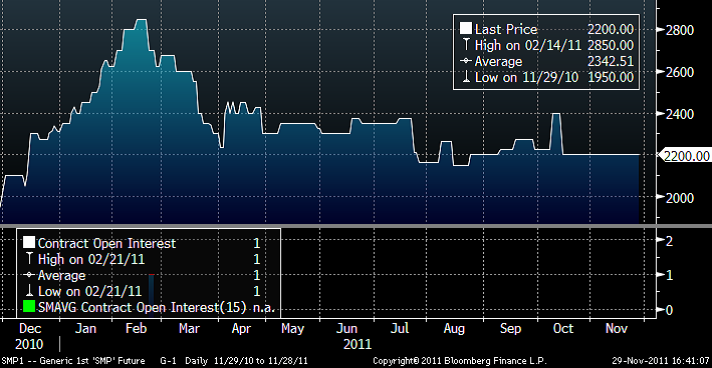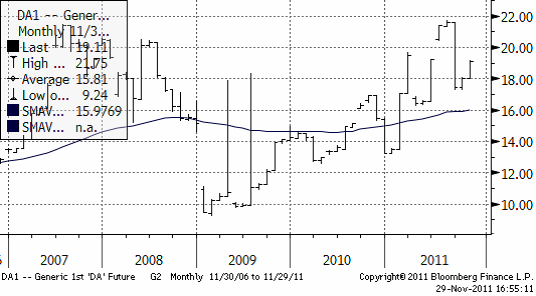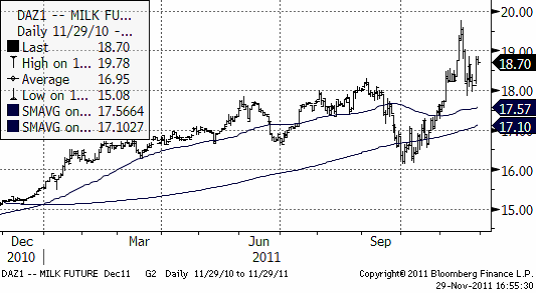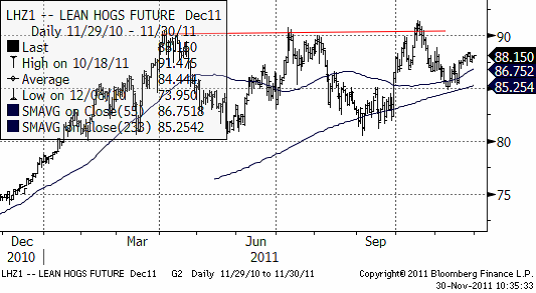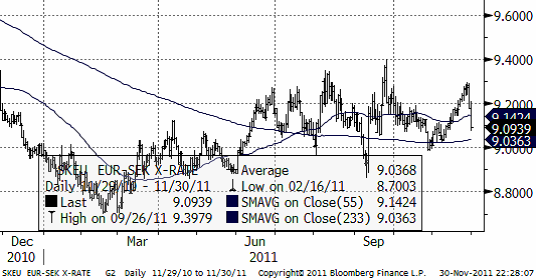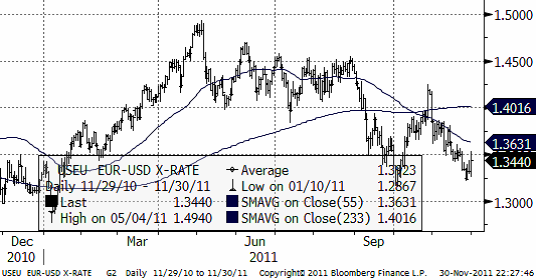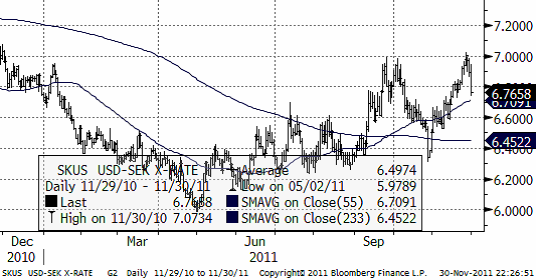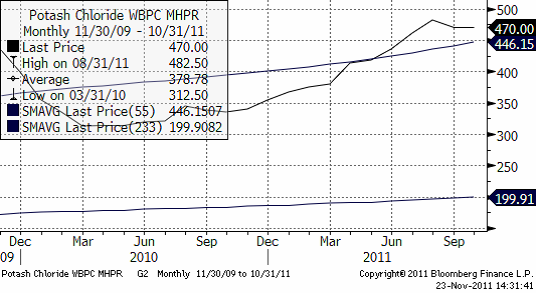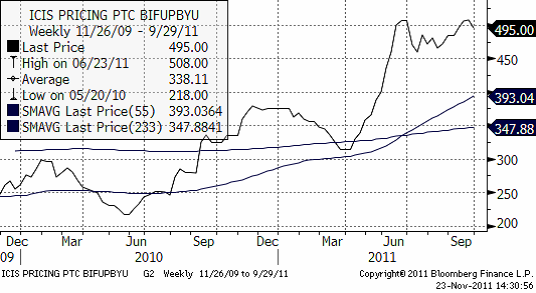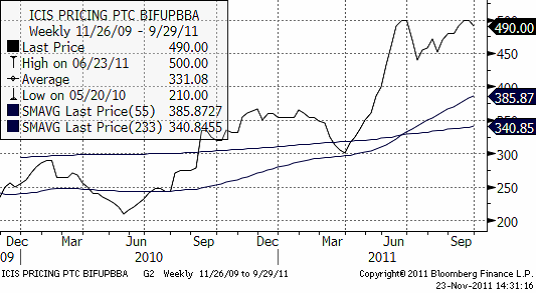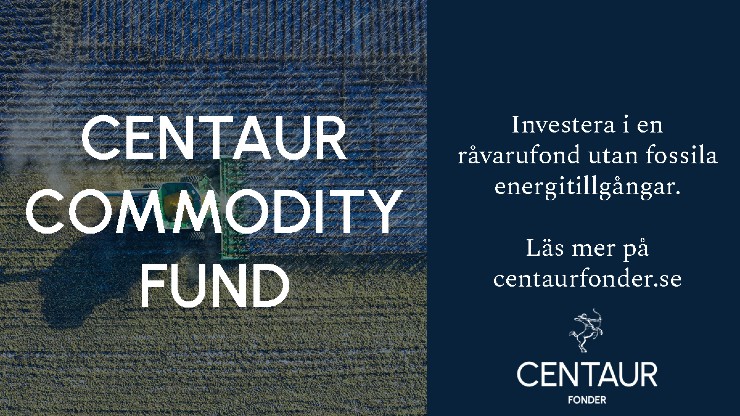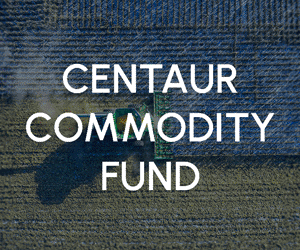Analys
SEB – Jordbruksprodukter, vecka 48
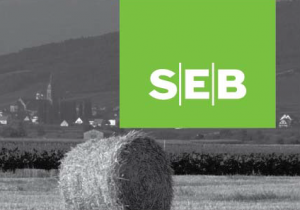 Att centralbankerna i 6 länder – USA (FED), Europa (ECB), Kanada, England, Japan och Schweiz bestämde sig för att sänka räntan för dollarlån till europeiska banker fick marknaderna – inklusive råvarumarknaden – att ta ett glädjeskutt. Beslutet var förvånande eftersom det inte just nu är en allmän brist på likviditet. Likviditetsbrist väntade marknaden skulle kunna ske först om ett år. Det gör att man tolkar beslutet som en ”signal” till marknaden att man vill släppa på pengar. Man kan tolka det som en viljeyttring att slå på sedelpressarna. Samtidigt har också misstanken kommit upp att det finns något som inte är känt. Vi känner ju till att Riksbanken t ex dolde hur illa det stod till för
Att centralbankerna i 6 länder – USA (FED), Europa (ECB), Kanada, England, Japan och Schweiz bestämde sig för att sänka räntan för dollarlån till europeiska banker fick marknaderna – inklusive råvarumarknaden – att ta ett glädjeskutt. Beslutet var förvånande eftersom det inte just nu är en allmän brist på likviditet. Likviditetsbrist väntade marknaden skulle kunna ske först om ett år. Det gör att man tolkar beslutet som en ”signal” till marknaden att man vill släppa på pengar. Man kan tolka det som en viljeyttring att slå på sedelpressarna. Samtidigt har också misstanken kommit upp att det finns något som inte är känt. Vi känner ju till att Riksbanken t ex dolde hur illa det stod till för
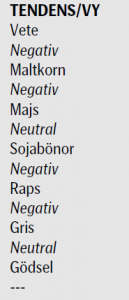 Swedbank år 2008. Världen lärde sig läxan från Lehman-konkursen. Man vill inte att det ska hända igen. Vi vet att franska banker ligger risigt till. Kommentatorer har frågat sig om det kanske var en fransk storbank som via detta drag räddats från ett akut konkurshot. I så fall är ”signalen” inte så positiv, utan ganska illavarslande.
Swedbank år 2008. Världen lärde sig läxan från Lehman-konkursen. Man vill inte att det ska hända igen. Vi vet att franska banker ligger risigt till. Kommentatorer har frågat sig om det kanske var en fransk storbank som via detta drag räddats från ett akut konkurshot. I så fall är ”signalen” inte så positiv, utan ganska illavarslande.
Den 9 december ska besked lämnas från eurozonens politiker. Möjligen håller man på att övertyga Tyskland om att slå på ECB:s sedelpressar av euro, när man nu gjort det med dollar. Råvaror kommer då att vara en förträfflig placering.
Efter att priserna på jordbruksprodukter initialt stigit, föll priserna tillbaka. Kanske var det den här ”konspirationsteorin” som påverkat. Men fundamenta för spannmål och sojabönor är också svaga och detta är antagligen det huvudsakliga skälet till att priserna stängde lågt i onsdags.
På onsdagen sänkte Kina kassakraven på landets banker – man lättar alltså på bromspedalen, som man haft intryckt i ett års tid. Landet söker säkerligen eftersträva stabilitet under 2012 års ledningsbyte. Det är den första sänkningen sedan 2008. Den här sänkningen tycks vara oberoende av de 6 stora centralbankerna. Under onsdagen rapporterades också att matpriserna i Kina stigit något den senaste månaden, lett av grönsaker.
Vete
Terminspriset på Matif-vete (mars) ligger på 178.5 euro. Den rekyl vi haft upp till 180-euro-nivån är ett säljtillfälle. Det är vanligt att man ser den här typen av rekyler upp mot utbrottsnivån och oftast är det den andra chansen för dem som missade att sälja vid utbrottet. Allt tyder på att vetepriset ska ner.
Argentina och även Brasilien är väldigt aggressiva på exportmarknaderna just nu. Det beror på att de vill bli av med den gamla skörden och skapa utrymme för den nya. Lite märkligt är det ändå – att Brasilien, som intar tredjeplatsen bland köparländerna, nu tycks vara en av de länder som sätter marginalpriset på vete i världen. Jordbruksverket kom idag med en rapport om just Argentinas och Brasiliens växande roll som ”brödkorg” för världen.
Annars fortsätter ryskt och ukrainskt vete att välla ut över Mellanöstern och Nordafrika. Troligtvis avtar flödet när vintern sätter in och försvårar logistiken. Häromdagen rapporterade Black Earth Farming om den usla logistiken som gör att de får tippa vete på asfalt under bar himmel. Regn förvandlar fint maltkorn och kvarnvete till foder, som bäst, enligt BEF.
Nedan ser vi terminskurvan för Chicagovete och Matif nu och för en vecka sedan. De ”feta” kurvorna är de aktuella. De ”smala” är förra veckans.
Allt talar för att Matif-vete faller ner i första hand till 150 – 160 – euro-nivån. På köparsidan hittar vi antagligen etanolfabrikanter.
Maltkorn
Maltkornsmarknaden följer vetet och det finns inga speciella nyheter att rapportera. Tekniskt ligger priset under glidande medelvärden. Den tekniska trenden är alltså nedåtriktad.
Potatis
Priset på potatis av årets skörd fortsatte stiga i veckan.
Nedan ser vi kursdiagrammet på europeisk potatis, som handlas på Eurex; terminen avser leverans april nästa år.
Majs
Majspriset har fallit till en teknisk stödnivå och marknaden präglas av oro för global efterfrågan. Det har varit torrt i Argentina och södra Brasilien och majsen är i en fas där den är känslig för torka. Glädjande nog väntas regn under nästa vecka. Den prognosen tynger naturligtvis marknaden.
Kina väntas importera majs.
Nedan ser vi marskontraktet på CBOT, där priset ligger på den nivå vid 600 cent där marknaden funnit stöd flera gånger. Den svagare dollarn gav ytterligare stöd för majspriset idag. Priset föll dock av ändå och stängde lågt.
USDA rapporterar att antalet kycklingar satta på uppfödning till broiler låg på den lägsta nivån sedan 2002. Det finns en säsongsvariation, som gör att det är lågt just nu, men 2011 ligger lågt som helhet, i nivå med krisåret 2009. Detta gör naturligtvis att efterfrågan på majs och även sojamjöl i USA är lågt.
Oljepriset tog ett skutt uppåt på centralbankernas utspel, men föll tillbaka under onsdagskvällen till en lägre prisnivå än i tisdags. Då måste vi också ta hänsyn till att dollarn försvagats. I kronor (eller euro) har oljepriset alltså fallit. I Europa har priset på etanol fallit 35 euro per ton sedan förra veckan.
Sojabönor
Priset på sojabönor befinner sig i en sjunkande trend. Det är en ”bear market”. Denna förstärktes för ett par dagar sedan när det tekniska stödet på 1167 bröts. Priset kan mycket väl gå ner mot 10 dollar.
Brasilianska säljare lär komma in allt mer och sälja ner priset. Vi är negativa ur tekniskt perspektiv de närmaste tre månaderna.
Raps
Rapspriset rör sig sidledes. Tekniskt ligger priset under 55-dagars glidande medelvärde och det gör att vi om något har en negativ vy. Även om bilden är otydlig är det fortfarande 400 euro som är prisobjektivet vi tror på.
Mjölk
Enligt önskemål tar vi upp bevakningen av mjölkmarknaden. Terminshandel finns främst på Chicago Mercantile Exchange, CME.
Det finns terminskontrakt sedan den 18 oktober 2010 på Matif i Paris, avseende torrmjölkspulver. Kontrakten avser 24 ton och det är leverans om man har en öppen position när kontrakten förfaller.
Priset är som vi ser nedan, 2200 euro per ton just nu. Vi ser också att intresset för de här terminskontrakten varit obefintligt (bokstavligt talat). 1 kontrakt har handlats sedan starten. Möjligen saknar marknaden motiv till handel eftersom det finns för få tänkbara deltagare. Antalet mejerier är för litet.
På CME handlas skummjölkspulver, men det mest handlade terminskontraktet avser USDA Class III priset för flytande mjölk. Den här typen av mjölk används för att tillverka ost. Kontraktet beräknas som USDA:s pris för Class III mjölk multiplicerat med 2,000. Priset anges i dollar per hundravikt (cwt) men avser 200,000 pund. Ett kontrakt är alltså värt 27,400 dollar när priset är 18.70 dollar / cwt. Naturligtvis är kontrakten kontant avräknade mot USDA:s pris; ingen leverans av flytande mjölk! Nedan ser vi priset på spotkontraktet över tiden. Notera att det uppstår hopp i prisnivån när ett nytt terminskontrakt blir det nya kortaste kontraktet och att det finns säsongsvariation i priset.
I diagrammet nedan ser vi decemberkontraktet 2011. Det avser priset nu i december och har därför ingen säsongsvariation som stör. Trenden är uppåtriktad och priset har stigit stadigt hittills i år, helt opåverkat av skuldkris.
Gris
Tekniskt vilar priset på lean hogs på de glidande medelvärdena. Att priset ligger över gör att trenden är uppåtriktad. Det har inte kommit några nämnvärda nyheter sedan förra veckan.
Valutor
EURSEK handlas i ett brett intervall, utan trend vare sig uppåt eller nedåt.
EURUSD har äntligen brutit nedåt och nu lär det gå fort. I första hand är nästa stöd 1.3145 dollar. I andra hand är det botten nere vid 1.2 dollar.
Den massiva korta valutapositionen mot Euro anses uppgå till 3 gånger den spekulativa långa positionen. Det gör att positiva nyheter om euron får större effekt på växelkursen än (ytterligare) negativa.
Inför årets slut brukar hedgefonder och liknande vilja minska sina risker. Det behöver inte bli så, men det kan bli så att euron då stärks när alla sålda positioner köps tillbaka.
USDSEK föll kraftigt som en reaktion på de sex centralbankernas samlade aktion att pumpa in dollar i ekonomin.
Gödsel
Kalium
Priset på kalium ligger kvar på samma nivå som för ett par veckor sedan.
Kväve
Nedan ser vi prisutvecklingen på Urea FOB Yuzhny i dollar per ton. Det har inte varit någon förändring.
Fosfor
Nedan ser vi prisutvecklingen på Diammoniumfosfat FOB Baltic i dollar per ton. Det har inte varit någon förändring från förra veckan.
[box]SEB Veckobrev Jordbruksprodukter är producerat av SEB Merchant Banking och publiceras i samarbete och med tillstånd på Råvarumarknaden.se[/box]
Disclaimer
The information in this document has been compiled by SEB Merchant Banking, a division within Skandinaviska Enskilda Banken AB (publ) (“SEB”).
Opinions contained in this report represent the bank’s present opinion only and are subject to change without notice. All information contained in this report has been compiled in good faith from sources believed to be reliable. However, no representation or warranty, expressed or implied, is made with respect to the completeness or accuracy of its contents and the information is not to be relied upon as authoritative. Anyone considering taking actions based upon the content of this document is urged to base his or her investment decisions upon such investigations as he or she deems necessary. This document is being provided as information only, and no specific actions are being solicited as a result of it; to the extent permitted by law, no liability whatsoever is accepted for any direct or consequential loss arising from use of this document or its contents.
About SEB
SEB is a public company incorporated in Stockholm, Sweden, with limited liability. It is a participant at major Nordic and other European Regulated Markets and Multilateral Trading Facilities (as well as some non-European equivalent markets) for trading in financial instruments, such as markets operated by NASDAQ OMX, NYSE Euronext, London Stock Exchange, Deutsche Börse, Swiss Exchanges, Turquoise and Chi-X. SEB is authorized and regulated by Finansinspektionen in Sweden; it is authorized and subject to limited regulation by the Financial Services Authority for the conduct of designated investment business in the UK, and is subject to the provisions of relevant regulators in all other jurisdictions where SEB conducts operations. SEB Merchant Banking. All rights reserved.
Analys
Tightening fundamentals – bullish inventories from DOE

The latest weekly report from the US DOE showed a substantial drawdown across key petroleum categories, adding more upside potential to the fundamental picture.

Commercial crude inventories (excl. SPR) fell by 5.8 million barrels, bringing total inventories down to 415.1 million barrels. Now sitting 11% below the five-year seasonal norm and placed in the lowest 2015-2022 range (see picture below).
Product inventories also tightened further last week. Gasoline inventories declined by 2.1 million barrels, with reductions seen in both finished gasoline and blending components. Current gasoline levels are about 3% below the five-year average for this time of year.
Among products, the most notable move came in diesel, where inventories dropped by almost 4.1 million barrels, deepening the deficit to around 20% below seasonal norms – continuing to underscore the persistent supply tightness in diesel markets.
The only area of inventory growth was in propane/propylene, which posted a significant 5.1-million-barrel build and now stands 9% above the five-year average.
Total commercial petroleum inventories (crude plus refined products) declined by 4.2 million barrels on the week, reinforcing the overall tightening of US crude and products.
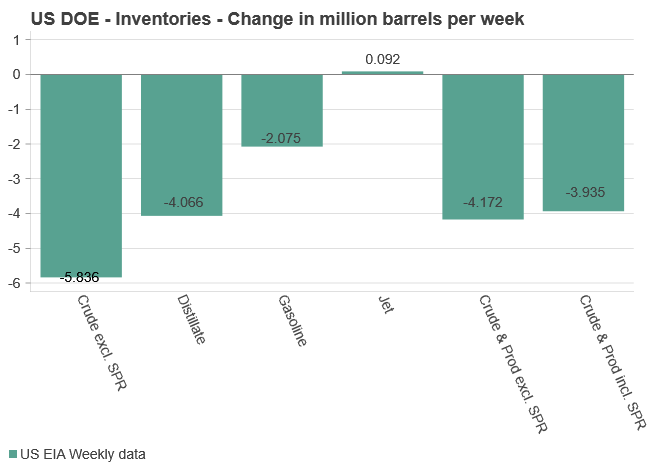
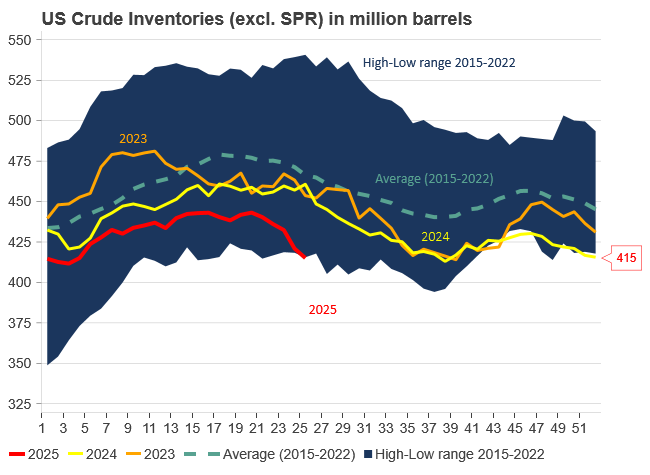
Analys
Bombs to ”ceasefire” in hours – Brent below $70

A classic case of “buy the rumor, sell the news” played out in oil markets, as Brent crude has dropped sharply – down nearly USD 10 per barrel since yesterday evening – following Iran’s retaliatory strike on a U.S. air base in Qatar. The immediate reaction was: “That was it?” The strike followed a carefully calibrated, non-escalatory playbook, avoiding direct threats to energy infrastructure or disruption of shipping through the Strait of Hormuz – thus calming worst-case fears.

After Monday morning’s sharp spike to USD 81.4 per barrel, triggered by the U.S. bombing of Iranian nuclear facilities, oil prices drifted sideways in anticipation of a potential Iranian response. That response came with advance warning and caused limited physical damage. Early this morning, both the U.S. President and Iranian state media announced a ceasefire, effectively placing a lid on the immediate conflict risk – at least for now.
As a result, Brent crude has now fallen by a total of USD 12 from Monday’s peak, currently trading around USD 69 per barrel.
Looking beyond geopolitics, the market will now shift its focus to the upcoming OPEC+ meeting in early July. Saudi Arabia’s decision to increase output earlier this year – despite falling prices – has drawn renewed attention considering recent developments. Some suggest this was a response to U.S. pressure to offset potential Iranian supply losses.
However, consensus is that the move was driven more by internal OPEC+ dynamics. After years of curbing production to support prices, Riyadh had grown frustrated with quota-busting by several members (notably Kazakhstan). With Saudi Arabia cutting up to 2 million barrels per day – roughly 2% of global supply – returns were diminishing, and the risk of losing market share was rising. The production increase is widely seen as an effort to reassert leadership and restore discipline within the group.
That said, the FT recently stated that, the Saudis remain wary of past missteps. In 2018, Riyadh ramped up output at Trump’s request ahead of Iran sanctions, only to see prices collapse when the U.S. granted broad waivers – triggering oversupply. Officials have reportedly made it clear they don’t intend to repeat that mistake.
The recent visit by President Trump to Saudi Arabia, which included agreements on AI, defense, and nuclear cooperation, suggests a broader strategic alignment. This has fueled speculation about a quiet “pump-for-politics” deal behind recent production moves.
Looking ahead, oil prices have now retraced the entire rally sparked by the June 13 Israel–Iran escalation. This retreat provides more political and policy space for both the U.S. and Saudi Arabia. Specifically, it makes it easier for Riyadh to scale back its three recent production hikes of 411,000 barrels each, potentially returning to more moderate increases of 137,000 barrels for August and September.
In short: with no major loss of Iranian supply to the market, OPEC+ – led by Saudi Arabia – no longer needs to compensate for a disruption that hasn’t materialized, especially not to please the U.S. at the cost of its own market strategy. As the Saudis themselves have signaled, they are unlikely to repeat previous mistakes.
Conclusion: With Brent now in the high USD 60s, buying oil looks fundamentally justified. The geopolitical premium has deflated, but tensions between Israel and Iran remain unresolved – and the risk of missteps and renewed escalation still lingers. In fact, even this morning, reports have emerged of renewed missile fire despite the declared “truce.” The path forward may be calmer – but it is far from stable.
Analys
A muted price reaction. Market looks relaxed, but it is still on edge waiting for what Iran will do

Brent crossed the 80-line this morning but quickly fell back assigning limited probability for Iran choosing to close the Strait of Hormuz. Brent traded in a range of USD 70.56 – 79.04/b last week as the market fluctuated between ”Iran wants a deal” and ”US is about to attack Iran”. At the end of the week though, Donald Trump managed to convince markets (and probably also Iran) that he would make a decision within two weeks. I.e. no imminent attack. Previously when when he has talked about ”making a decision within two weeks” he has often ended up doing nothing in the end. The oil market relaxed as a result and the week ended at USD 77.01/b which is just USD 6/b above the year to date average of USD 71/b.

Brent jumped to USD 81.4/b this morning, the highest since mid-January, but then quickly fell back to a current price of USD 78.2/b which is only up 1.5% versus the close on Friday. As such the market is pricing a fairly low probability that Iran will actually close the Strait of Hormuz. Probably because it will hurt Iranian oil exports as well as the global oil market.
It was however all smoke and mirrors. Deception. The US attacked Iran on Saturday. The attack involved 125 warplanes, submarines and surface warships and 14 bunker buster bombs were dropped on Iranian nuclear sites including Fordow, Natanz and Isfahan. In response the Iranian Parliament voted in support of closing the Strait of Hormuz where some 17 mb of crude and products is transported to the global market every day plus significant volumes of LNG. This is however merely an advise to the Supreme leader Ayatollah Ali Khamenei and the Supreme National Security Council which sits with the final and actual decision.
No supply of oil is lost yet. It is about the risk of Iran closing the Strait of Hormuz or not. So far not a single drop of oil supply has been lost to the global market. The price at the moment is all about the assessed risk of loss of supply. Will Iran choose to choke of the Strait of Hormuz or not? That is the big question. It would be painful for US consumers, for Donald Trump’s voter base, for the global economy but also for Iran and its population which relies on oil exports and income from selling oil out of that Strait as well. As such it is not a no-brainer choice for Iran to close the Strait for oil exports. And looking at the il price this morning it is clear that the oil market doesn’t assign a very high probability of it happening. It is however probably well within the capability of Iran to close the Strait off with rockets, mines, air-drones and possibly sea-drones. Just look at how Ukraine has been able to control and damage the Russian Black Sea fleet.
What to do about the highly enriched uranium which has gone missing? While the US and Israel can celebrate their destruction of Iranian nuclear facilities they are also scratching their heads over what to do with the lost Iranian nuclear material. Iran had 408 kg of highly enriched uranium (IAEA). Almost weapons grade. Enough for some 10 nuclear warheads. It seems to have been transported out of Fordow before the attack this weekend.
The market is still on edge. USD 80-something/b seems sensible while we wait. The oil market reaction to this weekend’s events is very muted so far. The market is still on edge awaiting what Iran will do. Because Iran will do something. But what and when? An oil price of 80-something seems like a sensible level until something do happen.
-

 Nyheter4 veckor sedan
Nyheter4 veckor sedanUSA slår nytt produktionsrekord av naturgas
-

 Analys4 veckor sedan
Analys4 veckor sedanAll eyes on OPEC V8 and their July quota decision on Saturday
-

 Nyheter2 veckor sedan
Nyheter2 veckor sedanStor uppsida i Lappland Guldprospekterings aktie enligt analys
-

 Nyheter3 veckor sedan
Nyheter3 veckor sedanBrookfield ska bygga ett AI-datacenter på hela 750 MW i Strängnäs
-

 Nyheter4 veckor sedan
Nyheter4 veckor sedanSommaren inleds med sol och varierande elpriser
-
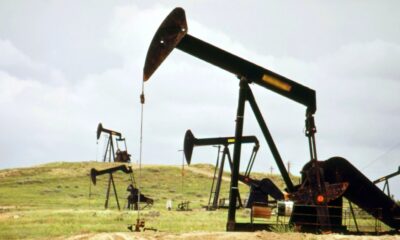
 Nyheter4 veckor sedan
Nyheter4 veckor sedanOPEC+ ökar oljeproduktionen trots fallande priser
-

 Nyheter3 veckor sedan
Nyheter3 veckor sedanSilverpriset släpar efter guldets utveckling, har mer uppsida
-

 Nyheter3 veckor sedan
Nyheter3 veckor sedanTradingfirman XTX Markets bygger datacenter i finska Kajana för 1 miljard euro


